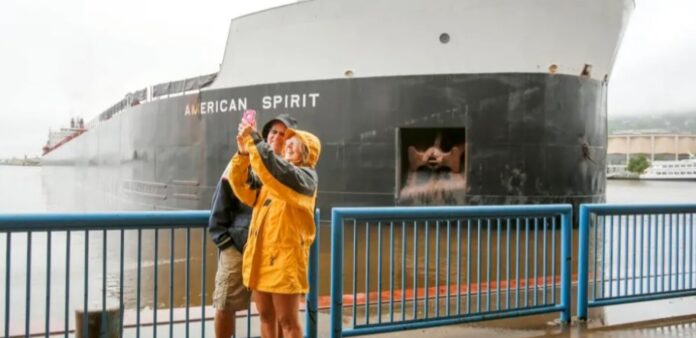Duluth is a world-class travel destination, and tourism is a major industry for our city.
So, it matters to all of us who live and work here how tourism performs and ripples through our economy.
Gary Meader / Duluth News Tribune
The pandemic slammed tourism the last two years, and 2022 was a rebound year. But exactly how well did tourism recover? And how well did those charged with promoting Duluth’s tourism message do their jobs?
Recently, city officials and the outside agencies hired to promote Duluth tourism pronounced their own assessment: A good job, they determined, based largely on data that included a 2022 tourism revenue increase over 2021 and previous years.
I decided to dive deeper, using publicly available online data — especially because the tourism industry, like many these days, promotes primarily online. Online marketing is what we do at our Duluth-based agency. And while we’ve participated in some city tourism marketing efforts over the years, my interest was simply as a Duluthian eager to surface more about what happened in 2022 with our tourism industry.
I asked some of the best in the business, experts who measure interest in brands of all kinds, to help me. We studied where most travelers start: Google. The world’s top search engine is one of the purest forms of measuring interest because it’s where would-be customers usually start their searches. Google Trends tells us who searches for what themes over time.
We measured search interest in Duluth quarterly, focused on travel and tourism categories for 2022 versus an average of Duluth’s 2018 and 2019 pre-pandemic levels. Using 2020 or 2021 would provide less-relevant data because they were years impacted by the pandemic.
For comparison purposes, we also looked at results for four other Upper Midwest cities of various sizes: Alexandria and Brainerd in Minnesota and Rapid City and Sioux Falls in South Dakota. These cities are nearby, have a range of travel attractions, and have varied promotional tactics and data that are worth comparing with Duluth’s.
The picture was not as rosy as what Duluth and its out-of-town agencies painted in their self-graded report card. Google search data is one of the most compelling predictors of brand interest, and Duluth’s Google search data is troubling at best. In 2022, quarterly travel and tourism search interest in Duluth was anywhere from 10.2% to 17.6% below Duluth’s pre-pandemic averages.
Meanwhile, the average performance of the four comparison cities in 2022 showed travel and tourism search interest ranged from a quarterly low of 4.6% below the pre-pandemic average to a quarterly high of 1.3% above pre-pandemic results.
While the other cities’ search performance trended close to pre-pandemic levels, Duluth’s did not. Throughout 2022, the four other cities significantly outperformed Duluth.
While base measures such as Duluth’s travel and tourism-revenue collections may be up from the pandemic years — and one would certainly hope so — our city has a long recovery ahead in the minds of travel searchers. More troubling, Duluth has a long way to go compared with regional cities that compete with us for visitors.
All of this matters because the search work of would-be visitors doesn’t happen in a vacuum. The city and the outside agencies helping spread the word about Duluth as a destination spend significant time and public money trying to do just that. Their audience? Those very searchers using Google who, according to the data, missed the message in 2022.
Across tourism-related categories — travel, tourism, hobbies and leisure, arts and entertainment, performing arts, and water sports — Duluth significantly underperformed its pre-pandemic results.
Google Trends doesn’t tell a positive story of tourism recovery for Duluth in 2022. But to be sure, we decided to check elsewhere. What do results from YouTube, the second-largest search engine, tell us? Beginning in late 2019, YouTube travel and tourism searches for Duluth climbed steadily. But YouTube search interest in Duluth plateaued and ended essentially flat in 2022 compared with 2021.
Additionally, paid online search keywords purchased by the Duluth team were almost devoid of phrases that included these and other obvious travel- and tourism-promoting words: fishing, lakes, Lake Superior, boating, wilderness, skiing, summer, leaves, foliage, Christmas, and vacation with kids.
Meanwhile, Travel South Dakota purchased phrases that included activities to do between Christmas and New Year’s Day as well as family-vacation ideas. Tourism-oriented search terms are a treasure trove for marketers seeking to win over those actively seeking purpose-driven destinations. Duluth seems to have ceded this ground to South Dakota.
Some keywords Duluth’s tourism team purchased actually were the same ones that local tourism businesses, hotels in particular, sought. That could have not only resulted in redundancy but also ratcheted up the cost of those keywords for the very businesses that the city was trying to help.
It’s great that overall tourism revenue collections for Duluth are up, as Mayor Emily Larson announced Nov. 30. She noted that the increase exceeded inflation. But after two years of a pandemic, a simple revenue increase is the least Duluthians should expect from their tourism leaders in a recovery year. And topline revenue is much too simple a metric to judge the performance of city officials and outside agencies paid with taxpayer dollars to make local tourism strong.
Far from roaring back, search interest in Duluth tourism is still crawling back to pre-pandemic levels. The city and its residents should expect better of its leaders and paid advisers, starting with the full story of how this important industry is performing in our community.
Marty Weintraub is the founder of Aimclear, a Duluth-based marketing and communications agency with local, national, and worldwide clients. He wrote this exclusively for the News Tribune.
Marty Weintraub











